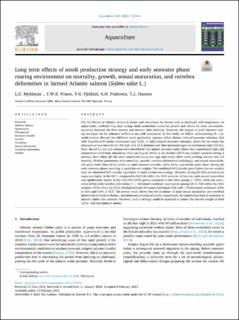| dc.description.abstract | The life history of Atlantic salmon is plastic and determined by factors such as daylength and temperature. In aquaculture, artificial long days during smolt production maximize growth and allows for early sea-transfer, occurring between the first summer and autumn after hatching. However, the impact of such intensive rearing strategies on the salmon's welfare is not well understood. In this study, we follow underyearling (0+) juvenile salmon through two different smolt production regimes, either dietary induced seawater tolerance (fed with SuperSmolt®) under continuous light (LLS), or light-induced seawater tolerance, where for six weeks the photoperiod was lowered to 12 h light and 12 h darkness and then increased again to continuous light (LD-LL). Next, the LD-LL and LLS salmon were distributed into indoor seawater tanks where they experienced light and temperature conditions simulating either an August (AUG) or an October (OCT) sea transfer scenario lasting 2 months, after which all fish were transferred into a sea cage and reared there until reaching harvest size (10 months). Welfare parameters were mortality, growth, vertebra deformities (radiology), and sexual maturation. LLS grew faster than LD-LL smolts up until seawater transfer, while LD-LL post-smolts grew faster during the early seawater phase, resulting in equal harvest weights. The simulated AUG transfer gave higher harvest weights than the simulated OCT transfer regardless of smolt production strategy. Mortality during the first period in sea cages was higher in the LD-LL compared to LLS fish within the AUG scenario. At harvest, male sexual maturation was significantly higher in the LLS AUG (21%) group compared to the other groups (∼10%), while the occurrence of fish with vertebra deformities (1 ≥ deformed vertebrae) was highest among LD-LL fish within the AUG scenario (31%). Only the LD-LL fish had severely deformed individuals (fish with >10 deformed vertebrae): 2.8% in AUG and 5.6% in OCT. The present study shows that the incidence of male sexual maturation and vertebral deformities is lower in dietary- and photoperiod-induced smolts, respectively, by transferring them to seawater in autumn rather than summer. However, such a strategy could be expected to reduce the harvest weight of both LD-LL- and LLS-induced smolts. | en_US |
